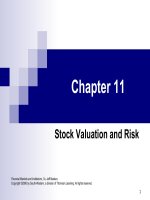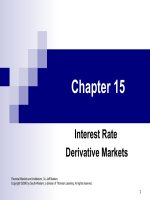Thị trường tài chính và các định chế tài chính_ Chapter 12
Bạn đang xem bản rút gọn của tài liệu. Xem và tải ngay bản đầy đủ của tài liệu tại đây (349.42 KB, 41 trang )
1
Chapter 12
Market Microstructure
and Strategies
Financial Markets and Institutions, 7e, Jeff Madura
Copyright ©2006 by South-Western, a division of Thomson Learning. All rights reserved.
2
Chapter Outline
Stock market transactions
How trades are executed
Regulation of stock trading
How barriers to international stock trading
have decreased
3
Stock Market Transactions
Placing an order
Brokerage firms:
Serve as financial intermediaries between buyers an sellers of
stock
Receive orders from customers and pass the orders on to the
exchange through a telecommunications network
Full-service brokers offer advice to customers on stocks to buy
or sell
Charge about 4 percent of the transaction amount
Discount brokers only execute the transactions
Charge about 1 percent of the transaction amount
The larger the transaction amount the lower the percentage
charged by many brokers
4
Stock Market Transactions (cont’d)
Placing an order (cont’d)
Investors communicate their order to brokers by specifying:
The name of the stock
Whether to buy or sell that stock
The number of shares to be bought or sold
Whether the order is a market order or a limit order
A market order to buy or sell a stock means to execute the
transaction at the best possible price
A limit order differs from a market order in that a limit is
placed on the price at which a stock should be purchased or
sold
5
Stock Market Transactions (cont’d)
Placing an order (cont’d)
Stop-loss orders:
Are orders where the investor specifies a selling price that
is below the current market price of the stock
Are typically placed by investors to either protect gains or
limit losses
Stop-buy orders are orders where the investor
specifies a purchase price that is above the current
market price
6
Stock Market Transactions (cont’d)
Placing an order (cont’d)
Placing an order online
Many brokers accept orders online, provide real-time quotes, and
provide access to information
Individual investors maintain more than 5 million online brokerage
accounts
About one of every seven stock transactions is initiated online
Traditional brokers have started to offer some online services
Some of the more popular online brokers include Ameritrade,
Charles Schwab, Datek, E*Trade, and National Discount Brokers
Average execution speed is about 8 seconds
7
Stock Market Transactions (cont’d)
Margin trading
A margin trade involves cash along with funds
borrowed from the broker
The Federal Reserve imposes margin requirements
which limit the amount of credit brokers can extend to
their customers
Currently, at least 50 percent of an investor’s invested
funds must be paid in cash
Margin requirements are intended to ensure that investors
can cover their position if the value of their investment
declines over time
8
Stock Market Transactions (cont’d)
Margin trading (cont’d)
Investors:
Must establish a margin account with their broker
Are required to satisfy a maintenance margin
Initially satisfy the maintenance margin with the initial
margin
Impact on returns
The return on stocks purchased on margin is:
INV
DLOANINVSP
R
+−−
=
9
Computing the Return on A
Margin Purchase
Billy purchases a stock on margin, borrowing 50% of the funds
necessary to complete the purchase. The stock is currently priced
at $50 per share, and the stock pays an annual dividend of $.50
per share. The brokerage firm charges an annualized interest rate
of 8%. After one year, the stock is sold at a price of $55 per share.
What is the return on the margin transaction?
%14
25$
50$.27$25$55$
=
+−−
=
+−−
=
INV
DLOANINVSP
R
10
Computing the Return on A
Margin Purchase (cont’d)
Reconsider the previous example, but assume that the stock declined
from $50 to $47 per share over the one year period. What would
the return on the margin transaction have been in this case?
%18
25$
50$.27$25$47$
−=
+−−
=
+−−
=
INV
DLOANINVSP
R
11
Stock Market Transactions (cont’d)
Margin trading (cont’d)
Impact on returns (cont’d)
Purchasing stock on margin increases the potential return
but magnifies the potential losses
12
Computing the Return on A Cash
Purchase
Compute the return that would have been realized in the previous two
examples if Billy had paid the entire price of the stock, without
borrowing on margin.
Stock Rises to $55:
Stock Falls to $47:
%11
50$
50$.50$55$
=
+−
=R
%5
50$
50$.50$47$
−=
+−
=R
13
Stock Market Transactions (cont’d)
Margin trading (cont’d)
Margin calls
If the investor’s equity no longer represents the minimum
percentage of the stock’s value required by the broker, the
investor may receive a margin call
With a margin call, the investor is required to provide more
collateral (cash or stocks) or sell the stock
The volume of margin lending on the NYSE reached a
peak of $278 billion in March 2000 and declined to $165
billion by August 2001
14
Stock Market Transactions (cont’d)
Short selling
In a short sale, investors place an order to sell a
stock that they do not own
Short sellers:
Anticipate a price decline
Essentially borrow the stock from another investor and will
ultimately have to provide that stock back to the investor
Make a profit equal to the difference between the original
sell price and the price paid for the stock after subtracting
any dividend payments made
15
Stock Market Transactions (cont’d)
Short selling (cont’d)
Measuring the short position of a stock
The ratio of the number of shares sold short divided by the
total number of shares outstanding is a measure of the
degree of short positions
The short interest ratio is the shares sold short divided by
the average daily trading volume
The higher the short interest ratio, the higher the level of
short sales
The short interest ratio is also measured for the market to
determine the level of short sales for the market overall
16
Stock Market Transactions (cont’d)
Short selling (cont’d)
Using a stop-buy order to offset short selling
Investors who have established a short position commonly
request a stop-buy order to limit their losses
e.g., an investor sells shares short for $50 per share and
places a stop-buy order with a purchase price of $60
If the stock price rises to $60 or over, the investor will pay
approximately $60 per share









